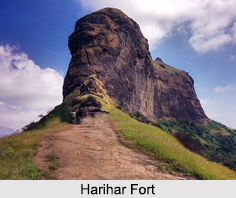 Harihar Fort is a small hill fort in Upper Vaitarana Range located in Nashik district of Maharashtra. Also known as "Harshagad Fort", it is an important fort in Nashik district, and was constructed to look upon the trade route through Gonda Ghat. Located atop a hill with an elevation of more than 3500 feet, it overlooks the nearby settlement of villages like Harshewadi. Today, the fort is in ruins and is only used as a trekking site.
Harihar Fort is a small hill fort in Upper Vaitarana Range located in Nashik district of Maharashtra. Also known as "Harshagad Fort", it is an important fort in Nashik district, and was constructed to look upon the trade route through Gonda Ghat. Located atop a hill with an elevation of more than 3500 feet, it overlooks the nearby settlement of villages like Harshewadi. Today, the fort is in ruins and is only used as a trekking site.
History of Harihar Fort
The history of Harihar Fort stretches back to the period of the Yadava dynasty between the 9th and 14th centuries. The fort was constructed to guard the trade route. Later on, it was captured by several other invaders and local rulers until it came under the control of the British army. It was surrendered to Khan Zamam in 1636 along with Trymbak and other forts in Pune. The fort was captured by Captain Briggs in 1818 along with 17 other forts.
Structure of Harihar Fort
The Harihar Fort has no good structures left except for a storage house with a small entrance. There is a series of rock-cut water cisterns in the centre of the fort. The fort has got a tapering plateau with a raised level in the middle. There is a small temple of Lord Hanuman and Lord Shiva on the plateau. A small pond is there in front of this temple and the water is potable. There is a small palace with two rooms inside the fort. There are five cisterns on one side of the palace, one of which has water suitable for drinking. There is a saffron flag hoisted at the highest point of the fort.
Trekking to Harihar Fort
Harshewadi and Nirgudpada are the two base villages of Harihar Fort. The climb from Harshewadi is much easier than from the Nirgudpada. A wide, safe trekking path starts from the hillock north of the Nirgudpada. It passes through scrub forest till it reaches an open ridge which is connected to the fort. It takes about an hour to reach the scarp of the hill on which the fort is situated. The ascent through the 60 m rock-cut steps is wonderful. It is like a stone ladder placed at 60 degree along the scarp. The steps are worn out at many places yet the holes on either side of the steps are conveniently cut for holding onto. After reaching the main entrance, the path takes a left traverse and again helical rock cut steps are to be climbed, which are steeper than the earlier. The steps finally end with a narrow entrance.
Visiting Information of Harihar Fort
The nearest airport to Harihar Fort is located in Mumbai and Nashik is the nearest railhead. From there one can get a direct cab to Harihar Fort. One needs to climb up a flight of rock-cut steps to reach the fort.



















